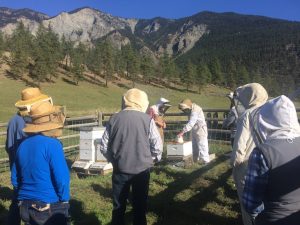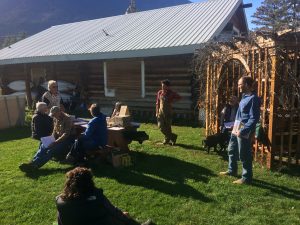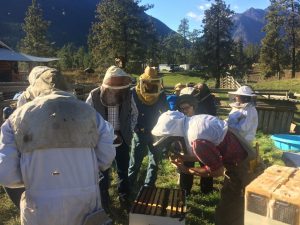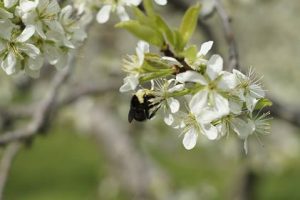
Our Beekeeping workshop with Bob Meredith and Mischa Chandler turned out even better than planned! Thanks to the beautiful, sunny October weather, Bob decided to bring a hive to open for everyone to have a closer look. The reason he had warned that we wouldn’t be opening a hive, is that if it weren’t warm and pleasant outside, the bees would not have been happy to be disturbed. (Bob likens it to someone ripping the roof off your house when you’re enjoying a cup of tea on a miserable day.) As it was, the bees seemed in quite a good mood, as no one got stung!
Bob started off our event by describing his history with beekeeping, as well as some of the history of beekeeping in Lillooet. As you can imagine, the two histories are thoroughly
 intertwined! Despite finding beekeeping to be incredibly rewarding, Bob cautioned that it is not what it once was. Due to the ever-increasing amount of diseases that can affect bee colonies in British Columbia, it is getting harder and harder to keep a healthy hive. And if you don’t have a healthy hive, you risk infecting other hives and other beekeepers’ livelihoods.
intertwined! Despite finding beekeeping to be incredibly rewarding, Bob cautioned that it is not what it once was. Due to the ever-increasing amount of diseases that can affect bee colonies in British Columbia, it is getting harder and harder to keep a healthy hive. And if you don’t have a healthy hive, you risk infecting other hives and other beekeepers’ livelihoods.After Bob’s presentation, we all headed over to the hive for a look!


There were enough veils for everyone to go in and get up close, while Bob and Mischa explained things like the smoke, how to spot the queen and many interesting facts about the life of bees. Things like how the guard drones keep watch at the entrance of the hive, what leads up to “swarming” in search of a new home, and how bees keep warm in the winter months.
After closing up the hive, Mischa talked to the group about why native bee species can be much better at pollinating, and what people can do to help pollinator populations thrive. Two good examples were to keep a messy gardens (bumble bees like to burrow and nest in the ground and like lots of organic material), and build a few mason bee houses. The best way to build a place for the mason bees is to drill some holes in a round of wood, and hang it up around your garden or house. He mentioned that range of sizes from 1/8inch to 5/16inch will include pretty much all local species.
We were very grateful to have a beautiful, sunny fall day to learn a bit about bees.


